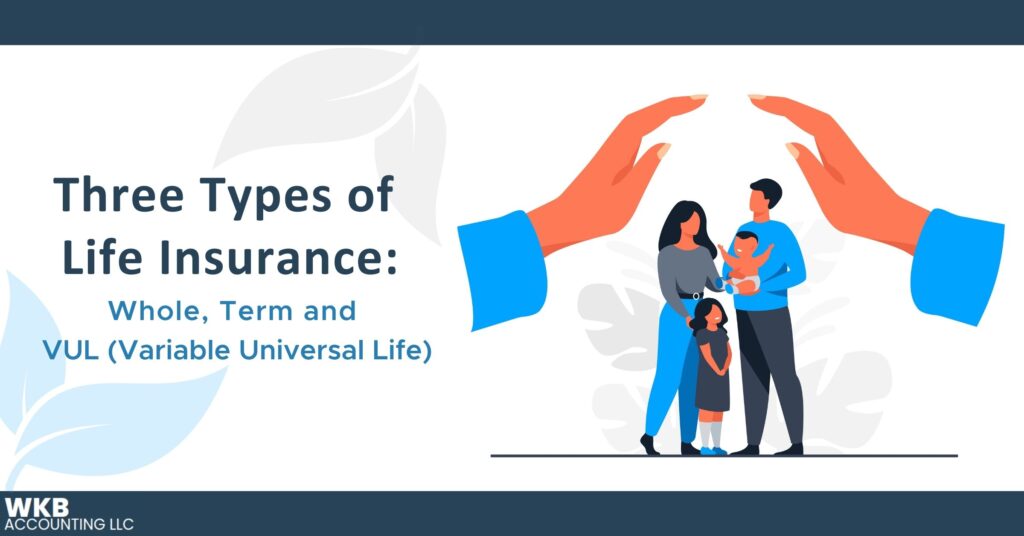Three Types of Life Insurance: Whole, Term and VUL (Variable Universal Life)

Life insurance is widely regarded as one of the most important investments you can make; however, it is one that many still overlook. According to statista.com, in 2021, only around 52% of adults in the US have a life policy, which means that almost half do not have any cover at all.
This article will focus on the three most common types of life insurance for you to have a better understanding of these policies. If you decide that you need a policy, you need to work out what type of coverage is most suitable.
Term Policy
Term insurance is less expensive than whole life insurance because you are renting the insurance. Your coverage is considered pure insurance in this case because it doesn’t develop cash value or participate in company dividends. Instead, it allows you to get the right amount of protection for the least expensive premiums available. If you choose this kind of policy, you will pay an exact amount for a certain period.
Once the period elapses, the insured person can forgo the coverage or have a different payment scheme to obtain further coverage. One of the finest points of this policy is that this could also help protect the beneficiaries from sudden financial losses and incapability, and if ever the insured person dies, their beneficiary will receive a death benefit.

Whole Life Policy
This is quite similar to the one mentioned above. The only difference here is that the individual insured will be covered for their entire life. This is the reason why it is also sometimes called “permanent coverage.” At the same time, it also allows the person to invest in choices that are a variety of investment choices offered by the insurance agency.
For some people, whole life insurance can be a great complement to their financial security. Here are other benefits attributed to the whole life policy.
1) It has a guaranteed return that will consistently build up the cash value on the policy.
2) It gives holders permanent insurance so that they are insured throughout their lifetime.
3) It allows them to stop paying premiums after a certain number of years because the dividends from the company will be enough to keep the policy going.
4) It allows policyholders to take cash from the policy in the form of a loan so that you have another option if liquidity is needed.
5) The growth of the policy is tax-deferred and tax-free as long as the policy is kept.
Also Read – Key Differences Between Traditional Ira and Roth Ira
Universal Life Insurance
Unlike other life insurance, variable life is considered an investment policy and regulated under federal securities laws. The insurance company must present a prospectus for the policyholder, who can choose from the portfolio offered to invest in stocks, equity, bonds, or money market funds. Only a portion of the premiums may be applied to the different funds.
Earnings from investments are not taxed until the policy is surrendered. If these earnings are sufficient enough, some can be diverted toward paying the premiums on the policy.
In good years, when the investment value rises, the value of the portfolio may grow. This may increase the value of the cash portion, and it may even be used to pay the policy premiums.
In down years, the reverse may be true. If the investment value declines, the premiums can get more expensive, too, requiring more money to pay the premiums to keep the life insurance in force.
Some VUL packages offer various thresholds that are guaranteed to help manage this risk. There could be a minimum death benefit that is pre-defined in the policy. There could also be a minimum that the insurer guarantees for the value of the cash accounts. It is important to fully understand your policy before you buy it!
Also Read – Understanding the Backdoor Roth Ira
Conclusion
There are several extras that can be attached to an insurance policy to provide extra protection and tailored to your particular circumstances. Critical illness coverage is a common addition and provides financial protection if the policyholder is diagnosed with a specified critical illness. This would provide a lump sum payment or recurring payments, which would be invaluable if you could no longer work or had to adapt to new circumstances.
Hopefully, this helps you understand the different options available. To further understand what package best applies to you, feel free to consult your Accountant, CPA or Bookkeeper and get their expert opinion.